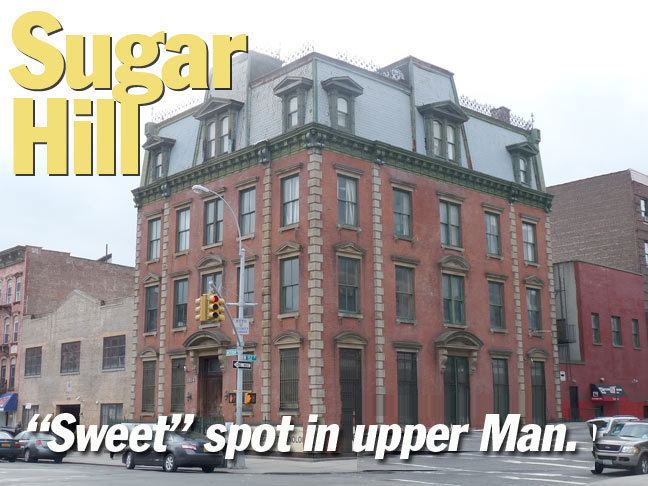Built 1883-1930 Area 30 ha | NRHP Reference # 02000360 Added to NRHP 11 April 2002 | |
 | ||
Location Roughly bounded by W. 155th St., 145th St., Edgecombe Ave. and Amsterdam Ave.Manhattan, New York City Architect Richard S. Rosenstock, Arthur Bates Jennings, Frederick P. Dinkelberg, Henri Fouchaux, Theodore Minot Clark, Neville & Bagge, Schwartz & Gross, George F. Pelham, Horace Ginsbern, C. P. H. Gilbert, Clarence True, John P. Leo, Samuel B. Reed, William Grinnell, William Schickel et al. Architectural style Queen Anne, Romanesque Revival, Renaissance Revival, Beaux-Arts, Neoclassical, Colonial Revival, Gothic Revival, neo-Grec, etc. Designated NYCL Hamilton Heights/Sugar Hill HD: June 27, 2000extension: October 3, 2001Hamilton Heights/Sugar Hill Northeast HD: October 23, 2001Hamilton Heights/Sugar Hill Northwest HD: June 18, 2002 Restaurants Farafina Café & Lounge, Tsion Cafe, P&M Classic Pizza and, Village Fried Chicken, Famous Deli Inc | ||
Sugar Hill is a United States historic district in the northern part of the Hamilton Heights section of the Harlem neighborhood of Manhattan, New York City. It is roughly bounded by West 155th Street to the north, West 145th Street to the south, Edgecombe Avenue to the east, and Amsterdam Avenue to the west. The equivalent New York City Historic Districts are:
Contents
Map of Sugar Hill, New York, NY, USA
The city districts were designated between 2000 and 2002, and the Federal district was listed on the National Register of Historic Places in 2002. The Federal district has 414 contributing buildings, two contributing sites, three contributing structures, and one contributing object.
Parks
Parks in the neighborhood include Jackie Robinson Park, St. Nicholas Park, and smaller sites such as Johnny Hartman Square, Carmansville Playground, and William A. Harris Garden.
History
Sugar Hill got its name in the 1920s when the neighborhood became a popular place for wealthy African Americans to live during the Harlem Renaissance. Reflective of the "sweet life" there, Sugar Hill featured rowhouses in which lived such prominent African Americans as W. E. B. Du Bois, Thurgood Marshall, Adam Clayton Powell Jr., Duke Ellington, Cab Calloway, Walter Francis White and Roy Wilkins.
Langston Hughes wrote about the relative affluence of the neighborhood in his essay "Down Under in Harlem" published in The New Republic in 1944:
If you are white and are reading this vignette, don't take it for granted that all Harlem is a slum. It isn't. There are big apartment houses up on the hill, Sugar Hill, and up by City College -- nice high-rent-houses with elevators and doormen, where Canada Lee lives, and W. C. Handy, and the George S. Schuylers, and the Walter Whites, where colored families send their babies to private kindergartens and their youngsters to Ethical Culture School.
Terry Mulligan's 2012 memoir "Sugar Hill, Where the Sun Rose Over Harlem" is a chronicle of the writer's experiences growing up in the 1950s and '60s in the neighborhood, where her neighbors included future United States Supreme Court Justice Thurgood Marshall, early rock n' roll legend Frankie Lymon, and New York baseball great Willie Mays, among other well-known names.
Notable buildings
Among the many notable buildings in the Sugar Hill area are:
